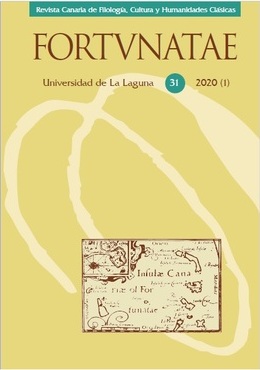Bizancio en la pantalla
Resumen
Los acontecimientos históricos más frecuentemente representados en el cine sobre el Imperio Bizantino son el reinado de Justiniano y su esposa Teodora, así como la trágica caída de Constantinopla el año 1453. Frente al inmenso caudal de películas de romanos y de filmes que beben de la mitología griega, a primera vista podría pensarse que el milenio bizantino no interesa como argumento cinematográfico. Sin embargo, contamos con una filmografía menos conocida, procedente sobre todo de Grecia y de Turquía, que aborda otros períodos y recrea la biografía de personajes históricos de gran importancia. El presente artículo trata de exponer la imagen de Bizancio a través de sus distintas relecturas cinematográficas y televisivas, partiendo desde el cine mudo hasta llegar a las últimas series de la pequeña pantalla.
Citas
AGATHOS, Th. & PAPADOPOULOS, Y. G. S. (2016): «Imperial palaces and village huts: Byzantium in Greek cinema and television», Mediterranean Chronicle 6: 243-258.
BALBO, L. (1998): «Turkish délices», CinémAction 89 (4): 91-94.
BAYRI, B. K. (2006): «Byzantium as represented in the Turkish cinema», en HAARER, F. K. & JEFFREYS, E. (eds.), Proceedeings of the 21st International Congress of Byzantine Studies. London 21-26 August 2006, vol. 2: Abstracts and Communications, London, pp. 42-43.
BAYRI, B. K. (2013): «Contemporary perception of Byzantium in Turkish cinema: the cross-examination of Battal Gazi films with the Battalname», Byzantine and Modern Greek Studies 37 (1): 81-91.
CANO ALONSO, P. L. (2014): Cine de Romanos: Apuntes sobre la tradición cinematográfica y televisiva del Mundo Clásico, Centro de Lingüística Aplicada Atenea, Madrid.
CARLÀ, F. (2013): «Prostitute, Saint, Pin-Up, Revolutionary: Theodora in 20th-Century Italian Reception», en KNIPPSCHILD, S. & GARCÍA MORCILLO, M. (eds.), Seduction and Power: Antiquity in the Visual and Performing Arts, Bloomsbury, London-New York, pp. 243-262.
CHRYSSOGELOS, K. (2019): «The Byzantine Heritage in Greek Cinema: the (almost) lone case of Doxobous (1987)», en SLOOTJES, D. & VERHOEVEN, M. (eds.), Byzantium in Dialogue with the Mediterranean. History and Heritage, Brill, Leiden-Boston, pp. 267-283.
CONCA, F. (2009): «Teodora, tra skene e palcoscenico», Koinonia 33: 47-60.
CORTÉS ARRESE, M. (2019): Vidas de cine: Bizancio ante la cámara, Catarata, Madrid.
DE ESPAÑA, R. (2009): La pantalla épica. Los héroes de la Antigüedad vistos por el cine, T&B, Madrid.
DE ESPAÑA, R. (2017): De héroes y dioses. 50 películas sobre la Antigüedad, UOC, Barcelona.
GARCÉS ESTALLÓ, I. & MONTSERRAT, J. D. (2019): «El viaje a ninguna parte: las carreras de carros de la Antigüedad vistas por el cine», en LAPEÑA MARCHENA, Ó. (ed.), El cine va de viaje, Université Paris-Sud, Paris, pp. 30-52.
GÜVEN AKDOGAN, Ö. (2019): «The Parody of Byzantium in the Turkish cinema: The perfidious Byzantium and Byzantine intrigues», en DINÇER, S. E. (ed.), Research and Reviews in Social, Human and Administrative Sciences, Gege Akademi, Ankara, pp. 89-102.
HERNÁNDEZ DE LA FUENTE, D. (2014): Breve historia de Bizancio, Alianza, Madrid.
KARALIS, V. (2012): A History of Greek Cinema, Continuum, New York.
KYRIAKOS, K. (2016): Epithymies kai Politiki. I Queer Historia tou Ellinikou Kinimatografou, Aigokeros, Athens.
LAPEÑA MARCHENA, Ó. (2019): «De viaje por el siglo V d.C.: De Reditu (C. Bondi, Italia, 2004); el Bajo Imperio en el cine», en LAPEÑA, Ó. (ed.), El cine va de viaje, Université Paris-Sud, Paris, pp. 275-309.
LILLO REDONET, F. (2011): «Enseñar la civilización bizantina a través del cine”, Methodos. Revista de didàctica dels estudis clássics 0: 1-7.
MARCINIAK, P. (2014): «And the Oscar goes to… the Emperor! Byzantium in the cinema», en NILSSON, I. & STEPHENSON, P. (eds.), Wanted: Byzantium. The Desire for a Lost Empire. Studia Byzantina Upsaliensia 15, Uppsala Universitet, Uppsala, pp. 247-255.
MORENO JURADO, J. A. (2017): De Bizancio a la Grecia contemporánea. Estudios sobre literatura griega, Centro de Estudios Bizantinos, Neogriegos y Chipriotas, Granada.
PASCHALIDIS, G. (2013): «Entertaining the Colonels: Propaganda, Social Change and Entertainment in Greek Television Fiction, 1967-1974», en GODDARD, P. (ed.), Popular Television in Authoritarian Europe, Manchester University Press, pp. 53-70.
PRIETO DOMÍNGUEZ, Ó. (2019): Casia de Constantinopla. Poemas, Cátedra, Madrid.
SALVADOR VENTURA, F. (2015): «La Teodora fílmica de 1954: una emperatriz cristiana y del pueblo», en LAPEÑA MARCHENA, Ó. & PÉREZ MURILLO, M. D. (eds.), El poder a través de la representación fílmica, Université Paris-Sud, Paris, pp. 311-325.
SCOGNAMILLO, G. (1998): «Türk Sinemasinda Bizans Oyunlari», Sanat Dünyamiz. Özei Bizans Saym 69-70: 155-163.
SCOGNAMILLO, G. & DEMIRHAN, M. (2005): Fantastik Türk Sinemasi, Kabalci Yayinevi, Istanbul.
SOLDATOS, Y. (2010): Historia tou ellinikou kinimatografou, Aigokeros, Athens.
SOLOMON, J. (2002): Peplum. El Mundo Antiguo en el cine, Alianza, Madrid.
VALVERDE GARCÍA, A. (2012): «Grecia antigua en el cine griego», Thamyris n. s. 3: 251-271.
Los autores conservan los derechos de autor y garantizan a la revista el derecho de ser la primera publicación del trabajo al igual que licenciarlo bajo una Creative Commons Attribution License que permite a otros compartir el trabajo con un reconocimiento de la autoría del trabajo y la publicación inicial en esta revista.
Los autores pueden establecer por separado acuerdos adicionales para la distribución no exclusiva de la versión de la obra publicada en la revista (por ejemplo, situarlo en un repositorio institucional o publicarlo en un libro), con un reconocimiento de su publicación inicial en esta revista.





